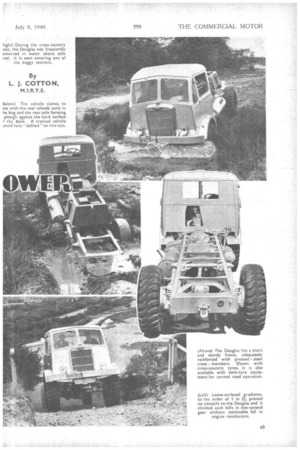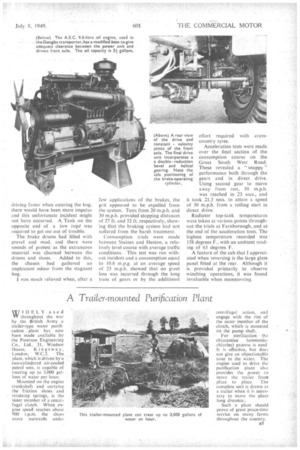1/401%111 CHUBS I Intl
Page 10

Page 11

Page 12

Page 13

If you've noticed an error in this article please click here to report it so we can fix it.
sw;th RESEW
By L. J. COTTON, /T was a stimulating experience to ride on the Douglas Transporter , when tackling the gradients of the big Farnborough Tank proving ground, and to see the ease with
which it climbed the hills. The .driver, showing contempt for a 1-in2i gradient, attacked the climb in third gear. He was not successful, but the hill was climbed in a lower ratio, with an ample reserve of power.
It might be thought that the Douglas is a ma-chine geared specially for such work, but with a maximum speed above 30 m.p.h. and a reasonable fuel consumption of a gallon to every 10.8 miles, there is little doubt that it is, in most respects, a normal-geared chassis.
A,E.C. 9.6-litre Engine This high performance is made possible by the use of the A.E.C. 9.6-litre oil engine, which develops 125 b.h.p. at its governed speed of 1,800 r.p.m. Apart from a modification to the sump, to provide ample clearance between the base of the engine and the drive of the front axle, the unit is the standard A.E.C. product.
The oil filter, although untouched during my test, is vulnerable at the front of the engine, and the design is being modified to enable the filter to be fitted in an alternative position. As the test chassis had the conventional right-hand drive, the normal engine, with accessories on the near side was fitted. For countries where left-hand control is employed, the A.E.C. power unit with accessories on the opposite side is supplied.
Drive from the engine is conveyed through a dry singte-plate clutch to 82
a four-speed gearbox. Third gear is in constant mesh, whilst the first and second ratios have sliding gears.
A Hardy Spicer shaft connects the main gearbox to the auxiliary and transfer boxes. The transfer box
provides a direct drive to the rear axle, and has arrangements for engaging four-wheel drive and a reduction gearing of 2.31 to I to assist in negotiating steep gradients or soft surfaces. Hardy Spicer shafts are used also between the transfer box and the two axles.
• Both axles are fully floating and have a double-reduction drive comprising bevel and double-helical gearing. The standard axle ratio is 7.9 to 1. The air compressor for the brake equipment is driven from the gearbox layshaft and supplies air to a reservoir behind the cab on the off-side frame member. To decrease the length of piping and eliminate time delay in the system, the brake operating valve is attached to the front of the reservoir. Conventional cam-operated shoes are employed.
The test chassis, one of an overseas order, was loaded with weights equivalent to a body, crane, winch and payload The winch, which was to be fitted to the chassis after test. is operated by compressed-air con trols mounted in the cab beside the, driver. This feature enables the driver easily to hold the winch brake against the heaviest of loads and gives positive operation, it is secured to the chassis frame by high-tensile
bolts, and can be removed for servicing without disturbing other components.
I started the test from the Pine hurst barracks at Farnborough, and within a short time had reached the "colonial section." As an aperitif, the Douglas was introduced to the soft-surfacedgradients, and I was more than surprised at the ease withwhich ,a 1-in-3.8 slope was climbed.
Up 1 in 2.74 The low set of ratios and fourwheel drive were ,engaged for this attempt, and the chassis roared up the incline at maximum engine revo
lutions in second gear. A similar technique was adopted for the 1-in3.18 gradient, and afterwards the 1-in-2.74 slope was climbed in thesame grand style.
At this juncture 1 found we had missed the I-in-2.98 gradient, and to prove that there was no ill-feeling, the driver tried to make the ascent in third gear. There was much soil, erosion at the foot of this gradient, and the machine sank through the soft surface. Despite all attempts, the vehicle could not be eased forward to the hard foundation and wheelspin developed. A similar setback. was encountered on the 1-in-2.43 gradient, sc■16 prove that the Douglas did not lack tractive energy, the drive:attacked the I-in2.25 concrete gradient, in second gear.There was no appreciable loss of ,engine revolutions as the chassis climbed the stiff gradient, and it rolled over the top almost as though traversing level ground This climb, accomplished with such ease, called for a further trial in a higher ratio: It was not possible te gather speed for a flying start, and we came to a halt part-way up the incline. I seized this opportunity to test the hand/brake and make a stopstart test. The foo, brake was depressed while the multi-pull brake lever was applied, and when the air brakes were released there was no sign of creeping down the hill.
A sharp forward application of the lever was required to release the brakes, arid no points were lost when the Douglas moved forward and gathered speed up the incline.
I then took control and drove over the " rough" Section, which consists of four to five miles of cross-country work through ditches and over hillocks, furrows and soft ground, which had been well ploughed by Tank tracks. Because of the dry spell before the test, some areas were rock hard, and the suspension was put to the test as the vehicle bumped over the rough surface.
I released my grip of the steering wheel for a second, and it spun like a top, causing the stub . axles to hammer against their stops. As nursed a damaged hand, I wished for the momeni that the steering was not quite so light
Good Ground Clearance
After performing every possible rnanceuvre with the machine, including running through a crater filled with water above axle level, an inspection was made of the chassis for signs of weaknesses or fouling. The chassis was still intact, and although I had driven over hillocks spaced at close intervals the only part that had touched ground was the hand-brake cross-shaft lever, which projects downwards amidships in the chassis.
Only the saddle bolts securing the
4-ton weight to the frame showed signs of weakness. These had stretched and opened beyond further use, and the weight was merely poised on the frame. Luckily, spare bolts were carried, and the unserviceable units were exchanged before continuing
With the co-operation of Col. Awdly, 0.C., B Vehicle Tests, War Department Experimental Establishment, and the use of his four-wheeldrive car, I reconnoitred the course in search of a boggy section, while the weights were being secured. I discovered a site covered with about 2 ft. of water.
When the Douglas arrived on the scene I took control and, not knowing what was to follow, engaged bottom gear. As the chassis rolled off hard ground into the bog, water was splashed over the windscreen and I slackened speed. The bog was partially forded, but I stalled the engine as we climbed the far bank.
The rear axle sank deeper as attempts were made to extricate the machine from the mire, and I gave up when the rear cross-member disappeared from view. Had I been driving faster when entering the bog, there would have been More impetus and this unfortunate incident might not have occurred. A Tank on the opposite end of a tow rope was required to get me out of trouble.
The brake drums had filled with gravel and mud, and there were sounds of protest as the extraneous material'. was churned between the drums and shoes. Added •to this, the chassis had gathered an unpleasant odour from the stagnant bog.
1 was much relieved when, after a few applications of the brakes, the grit appeared to be expelled from the system. Tests from 20 m.p.h. and 30 m.p.h. provided stopping distances of 27 ft. and 52 ft. respectively, showing that the braking system had not suffered from the harsh treatment.
Consumption trials were made between Staines and Heston, a relatively level course with average traffic conditions. This test was run without incident and a consumption equal to 10.8 m.p.g. at an average speed of 23 m.p.h. showed that no great loss was incurred through the long train of gears or by the additional
effort required with crosscountry tyres.
Acceleration tests were made over the final section of the consurnption course on the Great South • West Road. These revealed a " snappy " performance both through the gears and in direct drive. Using second gear to move away from rest, 30 m.p.h. was reached in 23 secs., arid it took 21.3 secs. to attain a speed of 30 m.p.h. from a rolling start in direct drive.
Radiator top-tank temperatures were taken at various points throughout the trials at Farnborough, and at the end of the acceleration tests. The highest temperature recorded was 158 degrees F., with an ambient reading of 63 degrees F.
A feature of the cab that [appreciated when reversing is the large glass panel fitted at the rear. Although it is provided primarily to observe winching operations, it was found invaluable when manceuvring.


























